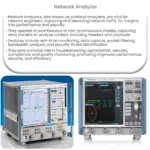Explore the role, functioning, types, applications, and future prospects of Inductive Network Analyzers in telecommunications.

Introduction to Inductive Network Analyzers
Inductive Network Analyzers are essential tools in the domain of electronics and telecommunications. Their primary role is to assess the performance of a network and detect any issues or areas for improvement.
At its core, an Inductive Network Analyzer leverages inductive reasoning to analyze data. It examines specific instances or observations to formulate a generalized conclusion, just like how inductive reasoning works in logic and mathematics. The inductive method is particularly beneficial when we need to work with an incomplete data set or when the complexity of a network restricts direct assessment.
Working Principle of Inductive Network Analyzers
Inductive Network Analyzers function by emitting a signal or a range of signals into the network and analyzing the resultant signals. This process helps in identifying parameters like impedance, gain, return loss, and other salient characteristics of the network. These details are pivotal for engineers and researchers in diagnosing and troubleshooting networks.
The power of Inductive Network Analyzers lies in their ability to take measurements at various points and frequencies within a network, allowing for a comprehensive analysis. This multifrequency approach enables these tools to assess networks with a high degree of accuracy, identifying even minor inconsistencies that could affect the network’s overall performance.
Types of Inductive Network Analyzers
-
Scalar Network Analyzers (SNA): SNAs are the simplest form of network analyzers. They can measure amplitude properties such as gain and attenuation, but they can’t evaluate phase properties.
-
Vector Network Analyzers (VNA): VNAs can measure both amplitude and phase properties. They are more advanced and versatile than SNAs, providing more detailed information about a network’s performance.
Despite their differences, both SNAs and VNAs utilize the inductive reasoning approach to extrapolate insights about a network from individual measurements. These insights are crucial in maintaining network performance and in developing new network designs.
Applications of Inductive Network Analyzers
Inductive Network Analyzers find widespread use in a variety of fields. Whether it’s telecommunications, wireless communications, data networking, or even in scientific research, these tools are invaluable. They aid in the development and maintenance of network infrastructure, ensuring that data transmission occurs smoothly and efficiently.
Among other things, these analyzers help in the design and testing of antennas, cables, filters, amplifiers, and other components of a network infrastructure. Their precision and versatility make them an indispensable asset in the electronics and telecommunications industry.
Features of Inductive Network Analyzers
Inductive Network Analyzers are equipped with numerous features that make them versatile and user-friendly. For instance, they typically offer a graphical user interface, providing visualizations of network parameters like gain and phase, thus aiding in better understanding and interpretation of results. They also have the capacity to store and recall measurement settings, enabling efficient retesting of networks.
The analyzers also possess advanced calibration techniques, such as Short-Open-Load-Through (SOLT) and Through-Reflect-Line (TRL). These calibration methods help in eliminating systematic errors, improving the accuracy of measurements.
The Future of Inductive Network Analyzers
The future of Inductive Network Analyzers is bright with constant advancements in technology. As networks become increasingly complex, there is a growing need for advanced tools to understand and maintain them. This need, in turn, drives innovation in the design and functionality of Inductive Network Analyzers.
One potential direction for the future is the incorporation of Artificial Intelligence (AI) and Machine Learning (ML) algorithms into these analyzers. This could allow the tools to learn from the patterns in the data they collect, leading to predictive analytics and more accurate fault detection.
Conclusion
In conclusion, Inductive Network Analyzers are powerful instruments in the field of electronics and telecommunications. By using inductive reasoning principles to measure and evaluate various network parameters, these analyzers provide insights that are crucial to maintaining optimal network performance.
Their wide range of applications, from testing components of network infrastructure to aiding in new network designs, underlines their importance in the industry. With ongoing technological advancements and the potential incorporation of AI and ML, Inductive Network Analyzers promise to remain an essential tool for network analysis and management.
As we move into an era of more connected devices and complex networks, the role of these analyzers in maintaining the integrity and efficiency of our communication infrastructure will only become more vital.



